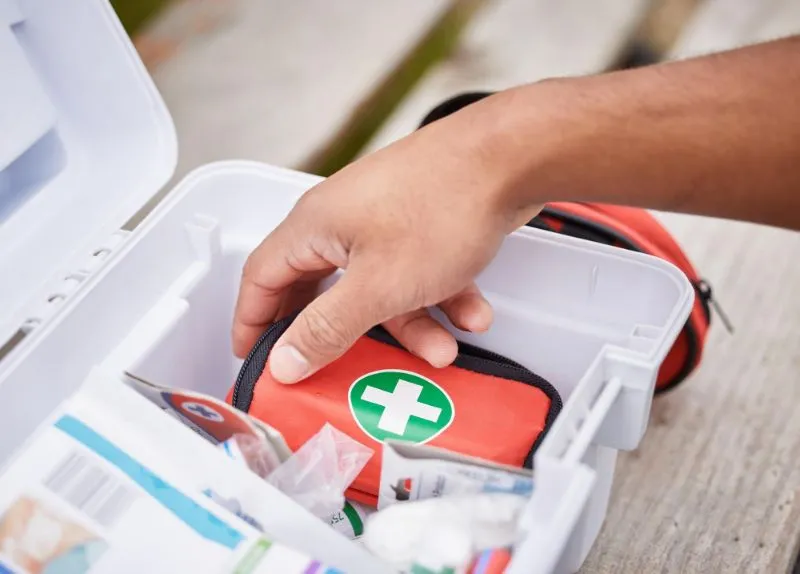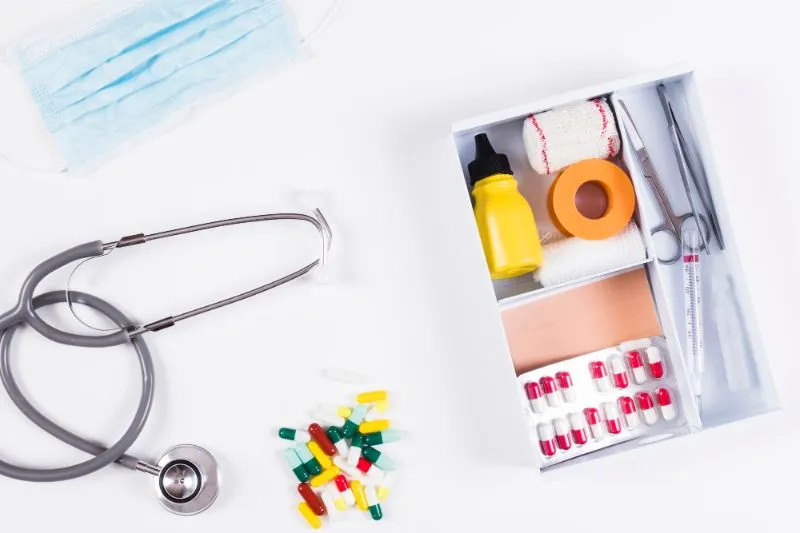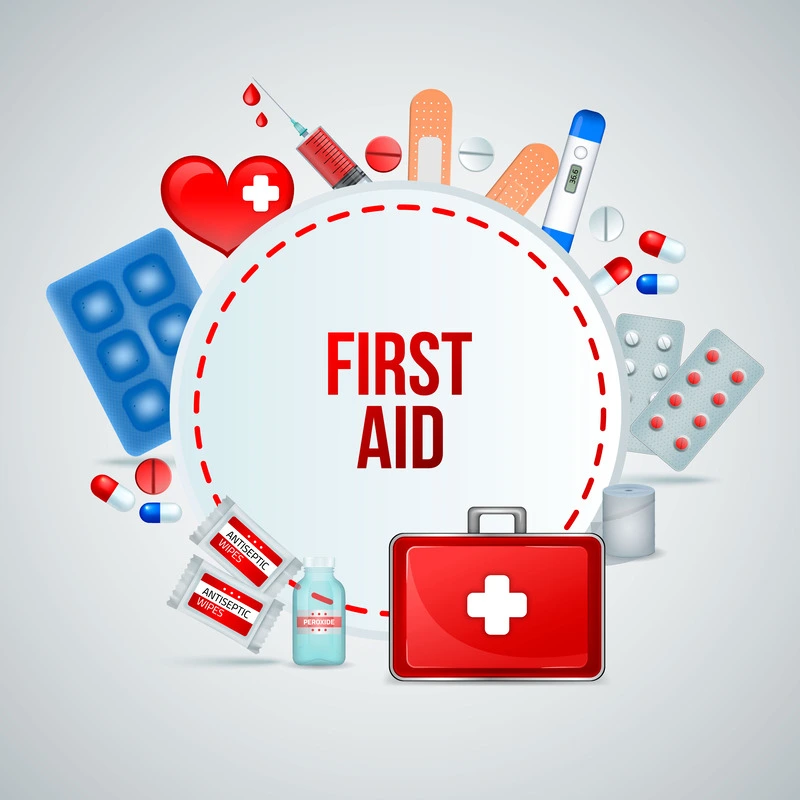Accidents and medical emergencies can occur anytime, catching us off guard. However, adequate preparedness can significantly enhance the likelihood of a positive outcome. One effective method is having a well-equipped first aid kit readily available at home. This comprehensive blog aims to provide valuable insights into assembling a first aid kit that encompasses the core components necessary to effectively address common injuries and medical incidents. Furthermore, we will delve into the importance of tailoring your first aid kit to suit your family's specific health requirements, offering practical tips on organizing your supplies for quick accessibility. In addition to the equipment and supplies, we will also discuss vital first-aid skills that every family member should be familiar with to respond to emergencies confidently. By the end of this blog, you will have learned to create an optimized and functional first aid kit, empowering your household to respond promptly and effectively in the face of medical emergencies.

The Core Components: Building a Comprehensive First Aid Kit
First aid refers to the initial medical assistance and care provided to individuals experiencing sudden injuries or medical emergencies before professional medical help becomes available. Having a well-equipped first aid kit and basic first aid skills can significantly affect the outcome of such situations. When assembling a comprehensive first aid kit for your home, it's essential to include a well-thought-out selection of items to handle common injuries and medical emergencies effectively. Following clinical guidelines, the core components of a first aid kit should encompass a variety of supplies, including:
a. Adhesive Bandages in Different Sizes: Adhesive bandages, commonly known as Band-Aids, are essential for treating minor cuts, abrasi3ons, and blisters. Including various sizes ensures that you can address wounds of different magnitudes appropriately.
b. Gauze Pads: Gauze pads serve multiple purposes, such as cleaning and covering wounds, applying pressure to control bleeding, and promoting proper wound healing.
c. Adhesive Tape: Adhesive tape is indispensable for securing gauze and dressings in place, especially for wounds that may require additional support.
d. Antiseptic Wipes: Antiseptic wipes containing substances like benzalkonium chloride or alcohol are crucial for cleaning and disinfecting wounds to prevent infections.
e. Hydrogen Peroxide: While hydrogen peroxide is commonly used for wound cleaning, it's essential to highlight that clinical guidelines recommend using it only for cleaning external wounds, not for ongoing wound care, as it can delay healing.
f. Scissors: Having a pair of sharp, medical-grade scissors allows you to cut gauze, dressings, or clothing if necessary during emergencies.
g. Tweezers: Tweezers are valuable for removing splinters or foreign objects from wounds. Opt for a fine-tipped, sterilized pair for safe and effective use.
h. Instant Cold Packs: Instant cold packs can provide immediate relief for minor sprains, strains, or bruises, reducing swelling and inflammation.
i. Gloves: Disposable gloves are a crucial component to protect both the first aider and the injured person from potential infections or cross-contamination.
j. Prescription Medications: If any family member requires prescription medications for chronic conditions (e.g., asthma inhalers, EpiPens for allergies), ensure they are readily accessible in the first aid kit.
k. Eye Wash Solution: Eye wash solution can be essential for flushing out debris or chemicals from the eyes in case of eye injuries or irritations.
l. Thermometer: A digital thermometer can help monitor body temperature and detect fever, which can be a sign of infection or illness.
Additionally, it is vital to keep the first aid kit in a secure and easily accessible location known to all household members. Regularly check and replace expired items and ensure the kit remains well-organized and fully stocked. By including these core components in your first aid kit, you can confidently address minor injuries and provide immediate care before professional medical help arrives. However, please remember that a first aid kit is not a substitute for proper medical evaluation and treatment. In cases of severe or life-threatening injuries, always call emergency services immediately. Moreover, the core components of a comprehensive first aid kit listed in this blog are based on general guidelines. The specific contents of your first aid kit may vary based on individual health needs and medical conditions. Please consult a qualified healthcare provider to customize your first aid kit to suit your family's unique requirements.
Customization Matters: Adapting Your Kit to Your Family's Needs
Customizing your first aid kit is not just about having a box with band-aids and a few pills; it's about preparing for potential medical emergencies and ensuring that you can provide optimal care for your family when they need it the most. Each family is unique, with individual members having different health conditions, age groups, and activities. Therefore, it is essential to tailor your first aid kit to cater to the specific needs of your family members. We will explore important points to consider when adapting your kit to ensure you are well-prepared for any situation.
Analyzing Family Members: The first step in customizing your first aid kit is to consider the health conditions and medical needs of each family member. Take note of any chronic illnesses, allergies, or ongoing treatments that require special attention.
Basic Supplies: Start with essential supplies that form the backbone of any first aid kit. These include adhesive bandages in various sizes, sterile gauze pads, adhesive tape, antiseptic wipes, and tweezers. These versatile items can be used for minor cuts, scrapes, and wounds.
Medications and Prescriptions: Ensure you have any necessary medications for chronic conditions, such as asthma inhalers, EpiPens for severe allergies, or insulin for diabetes. Keep a record of prescription medications for each family member, along with their dosages and instructions for use. Check expiration dates regularly and replace medicines as needed. Remember, this kit is not a substitute for doctor consultation or medical advice. Always consult a healthcare professional for personalized medical guidance.
Baby-Specific Items: If you have infants or toddlers, add baby diapers, wipes, diaper rash cream, baby-safe fever, and pain relief medication in the appropriate dosage. Ensure that these items are in good supply, considering the needs of your little ones.
Child-Friendly Items: For older children, include child-friendly adhesive bandages featuring their favorite characters, a digital thermometer designed for kids, and child-safe pain relievers in the appropriate dosage. Always keep these medications out of reach of children, and consult a healthcare professional before administering any new medications.
Senior Family Members: For elderly family members, pay attention to their unique health challenges. Consider adding items like pill organizers, hearing aid batteries, and mobility aids like a cane or walker. Ensure the kit is easily accessible, especially if mobility is an issue. For any specialized medical equipment, consult the appropriate healthcare provider.
Activity-Based Additions: Tailor your kit based on your family's activities. If you enjoy outdoor adventures, include items like blister pads, insect repellent, sunblock, and a compact emergency blanket. Add instant cold packs, athletic tape, and compression wraps for sports enthusiasts. Always follow proper safety guidelines and seek medical attention for severe injuries.
Emergency Contact Information: Keep a list of important emergency contact numbers, including your family doctor, pediatrician, local hospital, poison control center, and specialized medical contacts. Also, have a laminated card with essential medical information for each family member, such as blood type, allergies, and current medications. Include a contact person who lives outside your area, as they can be reached in case local lines are down during emergencies.
First Aid Manual and Training: Incorporate a comprehensive first aid manual in your kit to guide you through various emergencies. Additionally, consider taking a family first aid and CPR training course to ensure everyone knows how to respond effectively in emergencies.
Sanitary and Personal Hygiene Items: Don't overlook the importance of personal hygiene and sanitation during emergencies. Include items such as hand sanitizers, disposable gloves, facial tissues, and moist towels. These items can help maintain hygiene when access to running water is limited.
By customizing your first aid kit to accommodate your family's specific needs, you can significantly enhance the kit's effectiveness and responsiveness in addressing medical situations, providing reassurance and confidence to handle emergencies effectively. Stay informed about changes in your family's health status and update the kit to maintain relevancy over time.

Organizing for Efficiency: How to Arrange Your First Aid Kit
Properly arranging your first aid kit ensures easy access to essential supplies during emergencies, potentially saving valuable time and enabling prompt care. To organize your kit efficiently, consider the following key tips. First, group similar items together by categorizing supplies into sections, such as bandages, medications, and tools, making it easy to locate what you need quickly. Next, use clear and concise labels for each section or container within the kit, ensuring anyone can find the necessary supplies even in stressful situations. Store the kit in a cool, dry place away from direct sunlight, as extreme temperatures and moisture can compromise certain items' effectiveness. Consider using clear plastic containers or zippered pouches to hold supplies, allowing you to identify contents at a glance without rummaging through the kit. Include a comprehensive first aid manual for reference, handy for less experienced caregivers. Keep a list of emergency contact numbers readily accessible, and ensure all family members know its location. Regularly inspect and restock your first aid kit, replacing used or expired items and performing scheduled maintenance checks. Add a card with essential medical information if any family member has specific medical conditions or allergies. Periodically review and update the organization of your first aid kit, and train all household members on its organization and maintenance. By following these guidelines, you can ensure your first aid kit remains in optimal condition, ready to deliver necessary care promptly, providing you with peace of mind and confidence in handling medical situations.
Basic First Aid Skills: Must-Know Techniques for Home Use
Having basic first aid skills is essential for all family members as it empowers them to provide immediate care and support in case of injuries or medical emergencies until professional medical help arrives. Here are some fundamental first-aid techniques that everyone in the household should be familiar with:
a. Cardiopulmonary Resuscitation (CPR): CPR is a life-saving technique used when someone's breathing or heartbeat has stopped. The steps involve chest compressions to circulate blood and rescue breaths to supply oxygen. Proper CPR training is crucial to perform this technique effectively.
b. The Heimlich Maneuver: The Heimlich maneuver is used to dislodge a foreign object from the airway when someone is choking. It involves abdominal thrusts to create pressure and expel the object.
c. Controlling Bleeding: Knowing how to stop bleeding is vital in managing wounds and preventing excessive blood loss. The basic approach involves applying direct pressure to the wound using a clean cloth or bandage. It is essential to seek professional medical attention for severe or uncontrollable bleeding. While applying direct pressure to wounds can be helpful, some injuries may require specialized medical intervention.
d. Splinting Broken Bones: In the case of a suspected broken bone, immobilizing the injured limb with a splint can help reduce pain and prevent further damage. A splint can be made using rigid materials like cardboard or sticks, padded with a soft cloth. However, immobilizing a suspected broken limb with a splint can provide temporary support, but proper diagnosis and management by a qualified healthcare provider are necessary for a complete assessment and appropriate care.
e. Treating Burns: Immediate care for burns involves cooling the affected area under cold running water for several minutes. Covering the burn with a clean, non-stick dressing and avoiding home remedies like butter or ointments is important. In the case of severe burns or burns with blistering, seeking medical attention is crucial for proper assessment and treatment.
f. Insect Bites and Stings: Knowing how to treat insect bites or stings can help alleviate discomfort and prevent potential complications. This includes cleaning the area, applying a cold compress to reduce swelling, and using antihistamine creams or oral medications. However, it is essential to emphasize that antihistamines or other medications should only be used after consulting with a qualified healthcare professional. Individuals with a history of allergies or medical conditions must seek medical advice before using antihistamines or other medications. If an individual experiences severe allergic reactions, difficulty breathing, or any adverse symptoms after an insect bite or sting, they must immediately seek medical attention for appropriate evaluation and treatment.
To ensure the effectiveness of these first aid skills, consider taking a certified first aid training course from a recognized organization. These courses provide hands-on practice and comprehensive guidance on various emergencies, including those not mentioned above. Furthermore, it's essential to understand the limitations of first aid and recognize when professional medical attention is necessary. In severe or life-threatening situations, always call emergency services immediately, even if you have administered first aid.
Keeping Your Kit Up to Date: Regular Maintenance and Expiration Checks
Maintaining a well-equipped and up-to-date first aid kit ensures its effectiveness during emergencies. Regular maintenance and expiration checks help keep the kit fully functional and ready to provide the necessary care. Here are important steps to follow:
a. Expiration Dates: Regularly check the expiration dates of all medications, ointments, and other supplies in your first aid kit. Expired items may lose their potency and effectiveness, rendering them unsuitable for use. Discard any expired items promptly and replace them with fresh supplies.
b. Inspection Schedule: Set a schedule to inspect your first aid kit at least every six months or as recommended by the manufacturers of the products in the kit. Mark these dates on your calendar or set reminders on your phone to ensure consistency.
c. Replace Used Items: Replenish the supplies immediately after using any items from the kit during a medical emergency or minor injury. Do not wait for an emergency before checking and restocking the kit.
d. Customize for Changing Needs: As your family's medical needs or lifestyle changes, update the first aid kit's contents accordingly. For instance, add relevant medications or devices to the kit if a family member develops new allergies or medical conditions. Only include medications or medical supplies with a doctor's recommendation or prescription. Keeping the first aid kit relevant to your family's health requirements is crucial, but safety and appropriate usage must always take precedence.
e. Consider Seasonal Needs: Certain items may become more relevant depending on the season or specific activities. For example, during the summer, you might need additional supplies for insect bites or sunburns, while in winter may require extra items for cold-related injuries.
f. Check Equipment: Inspect any medical equipment, such as stethoscopes or blood pressure cuffs, for proper functioning. Ensure batteries and other power sources are operational in devices like flashlights or portable radios.
g. Update Emergency Contact Information: Review and update the list of emergency contact numbers regularly. Include the contacts of family doctors, local medical facilities, poison control centers, and emergency services.
h. Review First Aid Manual: Periodically review the information in your first aid manual to refresh your memory on handling various injuries and medical emergencies. Stay up to date with any changes in first aid protocols or guidelines.
i. Training and Education: Encourage all family members to participate in first aid training courses or workshops to reinforce their skills and knowledge. Regular practice of first aid techniques helps build confidence and familiarity.
By following these maintenance and updating guidelines, your first aid kit will remain fully functional, ensuring you can respond promptly and effectively during medical emergencies. A well-maintained first aid kit provides peace of mind and enhances your family's readiness to handle unexpected situations safely.

Preparing for the Unexpected: First Aid Readiness in Natural Disasters
In the event of natural disasters such as hurricanes, floods, or earthquakes, it's essential to have a first aid kit that can sustain your family for at least 72 hours. Natural disasters can strike unexpectedly and disrupt essential services, making it necessary to be prepared for emergencies that may last several days. Ensuring first aid readiness in such situations can be life-saving. Here's how to enhance your first aid kit to sustain your family for at least 72 hours during natural disasters:
Extended Supplies: Besides the core first aid components, consider adding extra quantities of essential items, such as adhesive bandages, gauze, and antiseptic wipes. Having ample supplies ensures you can manage multiple injuries over an extended period.
Emergency Rations: Include non-perishable, high-energy foods in your first aid kit to sustain your family's nutritional needs during an emergency. Granola bars, canned goods, dried fruits, nuts, and high-calorie snacks are suitable options.
Additional Water Bottles: Store additional bottles of potable water in your first aid kit to ensure an adequate supply for drinking and hygiene purposes. The general recommendation is to have at least one gallon of water per person per day.
Personal Medications: If any family member requires prescription medications, ensure you have a sufficient supply in the first aid kit to last for the anticipated duration of the disaster. Rotate these medications regularly to avoid expiration.
Flashlights and Batteries: Include battery-operated flashlights or headlamps with spare batteries in your kit to ensure visibility during power outages.
Portable Storage Containers: Use waterproof and portable containers to protect the contents of your first aid kit from water damage and make it easier to transport during evacuation.
Emergency Blankets: Add emergency blankets or space blankets to provide warmth and protection from extreme temperatures.
Face Masks: Include disposable face masks to protect against airborne particles, especially when air quality is compromised.
Personal Hygiene Supplies: Add personal hygiene items such as hand sanitizers, moist towels, and feminine hygiene products to maintain cleanliness and prevent infections.
Whistle: Include a whistle in your kit to signal for help if needed, as it can carry over longer distances than shouting.
Emergency Contact Information: Ensure your first aid kit includes updated emergency contact numbers, including local authorities, evacuation centers, and family members outside the disaster area.
Remember to periodically review and refresh the contents of your disaster-ready first aid kit, particularly regarding expiration dates of food, water, and medications. Store the kit in a readily accessible location known to all family members, and consider having multiple kits in different areas of your home. Additionally, create a family emergency plan and communicate it to all household members, outlining evacuation routes, meeting points, and designated responsibilities. Being prepared and having a well-stocked first aid kit can make a significant difference in the safety and well-being of your family during natural disasters. However, it is essential to conduct thorough research and follow official guidelines from emergency management authorities to ensure comprehensive preparedness for specific disaster scenarios.
Empowering Your Household: First Aid Training and Education
Empowering every household member with basic first aid skills is a proactive and essential step towards enhancing your family's safety and preparedness during emergencies. First, enroll in a certified first aid training class together as a family. Many organizations, community centers, and medical institutions offer courses tailored to different age groups. Learning as a family fosters teamwork and ensures everyone is on the same page regarding first aid techniques. To reinforce the skills learned during training, conduct regular practice sessions, and role-play various emergency scenarios. This will help family members become more confident in applying first-aid techniques.
Encourage active participation in maintaining the first aid kit, restocking supplies, and familiarizing themselves with the locations of different items. Hands-on experience builds competence and familiarity with the kit's contents, making it easier to respond effectively during crises.
Keep a comprehensive first aid book or manual in your first aid kit, serving as a valuable reference guide for all family members. Familiarize yourself with its contents to be better prepared during unforeseen situations. Adapt first aid education to each family member's age and maturity level. Teach younger children basic concepts, such as how to call for help, while older children and teenagers can learn more advanced techniques. Foster an open and supportive environment for family members to ask questions and seek clarification on first aid procedures. This helps solidify understanding and boosts confidence in applying first aid techniques.
For older family members, encourage pursuing formal first aid certifications, which can benefit their personal development and serve the community during emergencies. Lead by example and demonstrate a positive attitude towards learning first aid to inspire other family members to take the matter seriously.
Regularly revisit first aid skills and knowledge, even after initial training, as techniques may evolve. Consider attending refresher courses or updating training materials to keep everyone up to date. Empowering your household with first aid training and education prepares your family for potential emergencies and cultivates a sense of responsibility and care for one another.
By working together as a team, your family can confidently respond to medical situations and offer immediate assistance when it matters most. Remember, practice and ongoing learning are vital to maintaining proficiency in first aid skills. With a well-prepared and knowledgeable household, you can navigate through challenging situations with confidence, ensuring the safety and well-being of your loved ones.
Conclusion
Ensuring that your home is equipped with a comprehensive first aid kit is crucial to being prepared for unexpected medical emergencies. By customizing the kit to meet your family's unique needs, organizing its contents efficiently, and familiarizing yourself with basic first aid skills, you can increase your confidence in handling injuries and providing immediate care. Regularly checking expiration dates and updating the kit to reflect changes in your family's medical needs or lifestyle ensures it remains ready for use.
Furthermore, in your journey towards maintaining optimal health and wellness, Cura4U plays a vital role as a reliable healthcare partner. Cura4U offers comprehensive health services, including access to certified healthcare professionals and doctor consultations. Whether it's for obtaining medical advice, discussing health concerns, or seeking expert guidance on first aid techniques, Cura4U connects you with experienced healthcare providers who are ready to assist. Through Cura4U, you gain access to a wealth of health-related knowledge, medical resources, and tools, making it easier to make informed decisions about your family's health. Whether addressing minor health issues at home or seeking specialized medical attention, Cura4U provides a platform that fosters a proactive approach to healthcare. Remember, when it comes to health and well-being, safety comes first. By being prepared and empowered with knowledge and resources from Cura4U, you can confidently face any medical situation that may arise. Stay proactive, stay informed, and always be prepared to ensure the well-being and health of your family.
Our clinical experts continually monitor the health and medical content posted on CURA4U, and we update our blogs and articles when new information becomes available. Last reviewed by Dr. Tayyab Saeed Akhter on July 31st, 2023.
References
What should I keep in my first aid kit? - NHS (www.nhs.uk)- https://www.nhs.uk/common-health-questions/accidents-first-aid-and-treatments/what-should-i-keep-in-my-first-aid-kit/
First-aid kits: Stock supplies that can save lives - Mayo Clinic- https://www.mayoclinic.org/first-aid/first-aid-kits/basics/art-20056673
First-Aid Kit - Health Encyclopedia - University of Rochester Medical Center- https://www.urmc.rochester.edu/encyclopedia/content.aspx?contenttypeid=85&contentid=P00834
First aid kit: MedlinePlus Medical Encyclopedia- https://medlineplus.gov/ency/article/001958.htm
Building an At-Home First Aid Kit? Here Are 12 Essentials to Include (webmd.com)- https://www.webmd.com/first-aid/features/tip-sheet-what-to-keep-in-your-first-aid-kit
Traveler's First-Aid Kit | Johns Hopkins Medicine- https://www.hopkinsmedicine.org/health/wellness-and-prevention/travelers-firstaid-kit
Must-Haves for Your First-Aid Kit | Blogs | CDC- https://blogs.cdc.gov/publichealthmatters/2021/05/first-aid-kits/
Basic First Aid Supplies - Injuries and Poisoning - MSD Manual Consumer Version (msdmanuals.com)- https://www.msdmanuals.com/home/injuries-and-poisoning/first-aid/basic-first-aid-supplies













